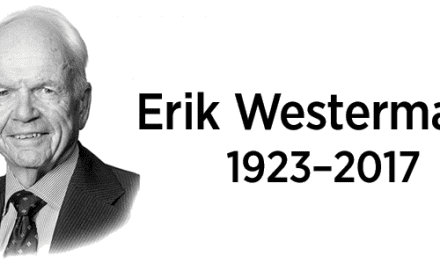A panel of expert hearing care professionals was convened to discuss the results of a survey and changing marketplace dynamics in hearing health care, as well as the opportunities presented by market changes. Among the most important trends are that older Americans are continuing to work through more advanced ages, and retired people are living more active lives—placing new and additional demands on their hearing care providers. Consequently, patients have higher expectations for hearing aids and services than in the past. Survey results demonstrated that patients highly value convenience, discreet hearing instruments, simple wear-and-forget devices, and hearing aids that can be upgraded after purchase.
In November 2010, Sona Hearing LLC (www.sonapro.com), a Sonova Group company, convened an expert advisory council of hearing care professionals in Chicago to discuss the results of a consumer survey, as well as the challenges and opportunities facing hearing care professionals in the United States (for members of the panel, see the Acknowledgements section at the end of this article). This article summarizes the key points of this endeavor.
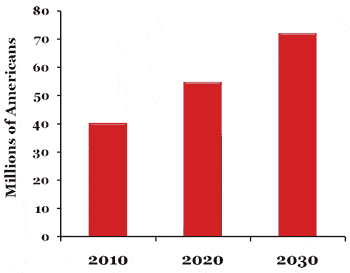
FIGURE 1. Number of Americans >65 years old. Source: US Census.1
Changing Marketplace Dynamics
The hearing care market is changing; patients have more demands on their lives, which, in turn, result in greater demands on the services provided by hearing care professionals. As the “Baby Boomer” generation ages, millions more Americans reach the 65+ year old age category (Figure 1). According to data from the US Census Bureau, there are currently about 40 million Americans who are older than age 65, but that number is projected to increase to 55 million by 2020 and 72 million by 2030.1
At the same time, due to economic conditions, more people are finding that they are unable to retire at age 65, and many older adults either remain in the workforce or return to the workforce. With more people working beyond retirement age, hearing loss can quickly become a significant problem that can affect job performance and wages.2,3 In addition, retired people currently have a more active lifestyle than in previous generations, which also increases the requirements for communication.
Another important consideration in the changing marketplace is hearing loss that affects a significant proportion of people who are younger than age 65, and recent data show that more than 50% of individuals with hearing impairment fall into this age category.4 Moreover, 1/14th (7.4%) of “Gen Xers” (ages 29-40) have hearing loss.5 Therefore, many business professionals find that hearing loss is affecting their ability to perform in the workplace; they may have trouble hearing in certain environments—such as in boardrooms, in meetings, or in crowded restaurants—which can significantly impact their performance. In fact, Kochkin2,3 has found a near-linear relationship between declining wages and the severity of untreated hearing loss.
Advisory council members shared their experiences regarding business professionals who are increasingly requesting hearing instruments for part-time use while not wanting to compromise on hearing performance. They are finding that many patients can benefit from part-time use of hearing instruments.
In addition to the changing marketplace dynamics, significant changes are also occurring in the expectations of patients, as described next.
Changing Expectations
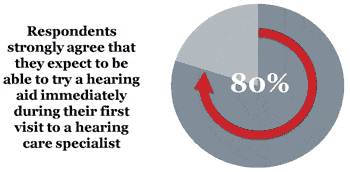
FIGURE 2. Expectations about same-day fitting, as reported in the consumer survey of 300 people with hearing loss who had not yet purchased a hearing aid.
As a result of the changing marketplace dynamics, the expectations of end users are changing. Modern-day retirees are more active and have more restraints on their free time. They are more likely to expect that hearing clinics are open on nights and weekends.
A recent survey of 300 people with hearing loss who had not yet purchased a hearing instrument revealed that patients want to be fit with a hearing aid without having to wait for 1 week and then take additional time for another clinic visit.
Time/convenience issues. In the survey, patients expressed a strong desire for same-day fitting of hearing instruments (Figure 2). Advisors shared their experiences and opinions on the value of same-day fitting, indicating that several of their patients—especially business professionals—expect to receive hearing aids on the same day of the initial fitting.
An analogy was made to 1-hour eyeglass outlets, which are able to service clients in a very short time period and deliver product immediately. It was clearly recognized that hearing assessments and fittings are significantly more complex than vision assessments and fittings, but the main idea was that patients want “immediate gratification” and that many of them are under tighter time constraints than in previous generations.
Patients also indicated that they cannot afford to be without their hearing aid and are not inclined to wait for a hearing aid to be shipped to the dispensing professional or for time-consuming repairs to their devices. In the survey, the majority of patients indicated that getting “an immediate exchange if your hearing aid breaks down” was desirable, with 43% stating that this was a “basic requirement” (Figure 3).
Simple solutions. In terms of convenience, patients also seek solutions that are simple and that will not complicate their lives. In the survey, having a “wear and forget” hearing aid that is easy to handle was a strong positive influence on the buying decision (Figure 4).
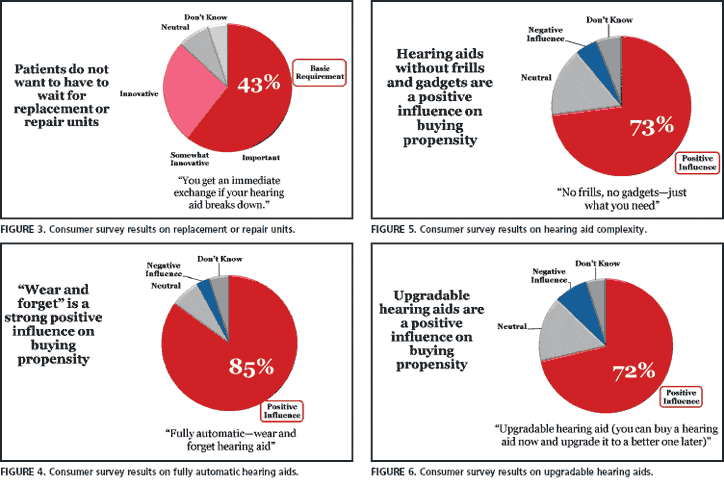
This was echoed by the finding that hearing aids without “frills and gadgets,” thus representing easy-to-use devices with no additional buttons or controls, also had a positive influence on the buying decision (Figure 5).
Interestingly, while respondents favored “wear and forget” hearing instruments, they also preferred to have hearing instruments that can be upgraded after the purchase (Figure 6). Therefore, although patients prefer a simple solution, they also seek flexible, sophisticated hearing instruments that are able to be upgraded after the purchase if their needs change.
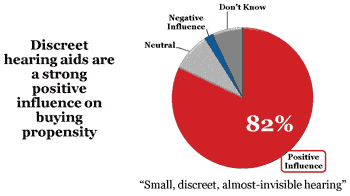
FIGURE 7. Consumer survey results on discreet hearing aids.
Size remains important. Patients also prefer hearing instruments that are discreet. Respondents to the survey showed a strong preference for hearing instruments that are “small, discreet, almost invisible” (Figure 7), suggesting that aesthetics continue to play an important role in patient selection of hearing instruments.
Market Changes Lead to New Opportunities
The changing marketplace dynamics and increased patient expectations provide important opportunities for hearing care professionals who can meet these new demands and needs. As described above, demographics show that increasing numbers of people are entering ages in which they will require hearing instruments, and many of these people will remain in the workforce longer than those of previous generations. Specifically, the survey suggests patients in today’s marketplace desire:
- Convenience: same-day fitting and immediate replacement of broken instruments;
- Discreet hearing instruments: small devices that do not draw attention;
- Simple solutions: wear and forget, no extra frills and gadgets; and
- Flexible solutions: the ability to upgrade after the purchase.
To some extent, success relies on one’s ability to respond to these needs. For example, in today’s marketplace, hearing care professionals who offer same-day fitting provide an important service and have a significant competitive advantage. However, this can be a challenge for some dispensing offices and clinics, due to the need to stock sufficient numbers and varieties of hearing instruments to meet patients’ needs.
A significant proportion of patients also want simple, wear-and-forget hearing aids, as well as devices that are discreet. Upgradability after the purchase is a new concept in the industry and there is now an option for this. By taking advantage of the right products and services, hearing care professionals can capitalize on the new opportunities in the industry.
New Solutions for Meeting Patient Needs
Manufacturers are recognizing these new trends in the industry, and some offer programs and services that help hearing care professionals compete and succeed in the changing environment. For example, all major manufacturers offer high-quality hearing instruments. In addition, most manufacturers offer hearing aids that are very discreet. Advisory council members indicated that several hearing aid brands and models all fit either completely in the canal or almost completely in the canal, are not noticeable, and are well received by patients.
Same-day fitting is an attractive service for many busy professionals who require hearing instruments (Figure 2). This is being offered at many, if not most, dispensing offices; however, hearing care professionals often find it a challenge to have sufficient stock on hand to be able to provide same-day fitting. Sona Hearing offers a service called “smart:stock” that includes consignment stock and automatic replenishment of stock. This enables hearing care professionals to have sufficient stock available to perform same-day fitting without having capital tied to the stock. The patients can immediately experience a high-quality, professionally prescribed hearing solution, making it easier for them to decide whether they are satisfied with that hearing solution. Having been fit on the first visit saves an extra visit for the dispensing professional and the patient, as the next visit becomes the one focused on fine-tuning.
Advisory council members considered smart:stock to be a significant advantage also in terms of time saved because of outsourced stock management. The time gained can be used to the benefit of not only hearing care professionals but also their patients.
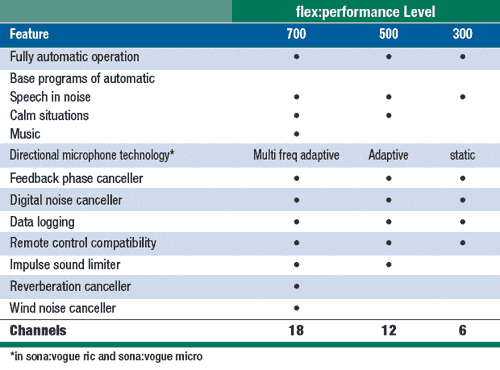
Table 1. Features of the three flex:performance levels offered in Sona hearing aids.
As shown in Figure 3, the majority of patients consider an immediate exchange of malfunctioning hearing instruments a basic requirement. All major manufacturers offer repair of hearing instruments when the units malfunction. However, Sona Hearing offers instant replacement of hearing instruments for up to 1 year after purchase (another benefit of smart:stock).
One of the interesting results from the survey was that patients would like upgradable hearing instruments. Most hearing instruments provide one set of algorithms and features and cannot be reprogrammed to have a different set of algorithms. In contrast, Sona Hearing offers a feature called flex:performance. With flex:performance, 1 of 3 performance levels can be selected and signal processing algorithms uploaded during fitting (Table 1). This is not merely an adjustment of the fitting parameters in the units, but an actual performance-level change—a delivery of different algorithms that provides different levels of features to the hearing aids.
The clinician can also change the performance level during the first 2 years of service to meet the evolving needs of patients. At the advisory council meeting, a story was conveyed about a patient who could afford only the 300-level device. He obtained his sona hearing instruments and was happy with them. Several months later, his wife received a bonus, and the patient was able to upgrade his hearing instruments to the 500-level, enjoying greater features. Because he was anticipating the purchase of a boat within a year, his hearing care professional advised him that, if the wind on the boat bothers him, he may consider upgrading to the 700-level to correct for the wind noise.
This illustrates how flex:performance can help dispensing professionals meet changing patient needs in a way that was not previously possible. It provides a new option that is of particular interest for first-time users, as they often don’t know what to expect from a hearing solution and have a tendency to make decisions based on price.
It was also stated that an upgradable hearing aid can be used as an attractive entry-level device to fit patients with mild hearing loss earlier.
Conclusions
Because of changing expectations and marketplace dynamics, a practice can gain a significant competitive advantage by offering the latest products and services. By addressing patient needs for convenience (same-day fitting, immediate replacement), discreet hearing instruments, simple solutions, and flexible upgradable hearing aid options, dispensing professionals can improve their practices and businesses.
Several manufacturers offer services and solutions that can help meet these new and changing patient needs. In particular, Sona Hearing offers a collection of services (eg, smart:stock and flex:performance) that enables hearing care professionals to meet patient needs now and into the future.
Acknowledgements
The author and Access thank the members of the expert advisory council who provided input related to this report: Tricia Ashby, AuD, Townson University, Townson, Md; Bopanna B. Ballachanda, PhD, Premier Hearing Centers, Sante Fe, NM; William W. Dickinson, AuD, Vanderbilt University, Nashville, Tenn; Denny P. Dingler II, BC-HIS, Professional Hearing Centers, Inverness, Fla; Timothy C. Dunnigan, AuD, Advanced Hearing Technology, Naples, Fla; Donald Hawley, MS, BC-HIS, Sound Advice Hearing Solutions LLC, St Petersburg, Fla; Victoria A. Hingst, AuD, Advanced Hearing Technology, Naples, Fla; Gail Linn, AuD, Potomac Audiology, Rockville, Md; David E. Rich, PhD, Binson’s Hearing Aid Services LLC, Clarkston, Mich; Diane Shrager, MS, private practice, Arlington Heights, Ill; Gregory D. Wales, BC-HIS, Wales Hearing Center, Alexandria, Minn.
References
- US Census Bureau. Population Projections – 2008 National Population Projections: Summary Tables. www.census.gov/population/www/projections/summarytables.html. Accessed December 10, 2010.
- Better Hearing Institute. Hearing Loss and Its Impact on Household Income: A special report on new data generated by the Better Hearing Institute. Hearing Review. 2005; 12(11):16-24.
- Strom KE. HR interviews Sergei Kochkin, PhD. Hearing Review. 2005;12(11):24-32,82.
- National Academy on an Aging Society. Hearing Loss: A Growing Problem That Affects Quality of Life. Available at: www.agingsociety.org/agingsociety/pdf/hearing.pdf Accessed December 20, 2010.
- Kochkin S. MarkeTrak VIII: 25-year trends in the hearing health market. Hearing Review. 2009;16(11):12-31. Accessed December 21, 2010.
Citation for this article:
Morla A. Four transformative patient demands: Convenience, size, simplicity, and flexibility. Hearing Review. 2011;18(4):36-42.




